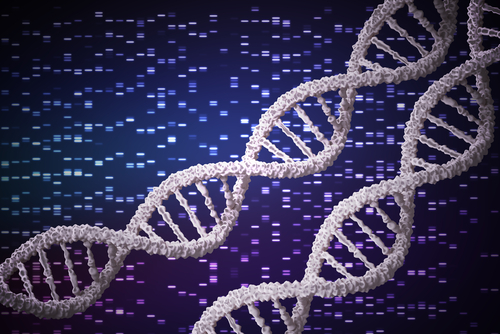Double HSPB1 Mutations Linked to CMT2F in Two Patients

vchal/Shutterstock
Researchers identified double disease-causing HSPB1 mutations in two unrelated adults with Charcot-Marie-Tooth disease type 2 subtype F (CMT2F), according to a case report.
While mutations in the HSPB1 gene have been associated with CMT2F, they are usually found in only one of the gene’s copies, in which case it’s known as a heterozygous mutation.
These two reported cases are the first in which patients were found to carry one of the two most common disease-causing mutations — p.S135F and p.R136L — in both HSPB1 gene copies. In these cases, the mutations are called homozygous.
Notably, carrying these double HSPB1 mutations was not associated with more severe disease than that previously reported in patients with the mutation in only one of the gene’s copies.
The study, “Charcot–Marie–Tooth disease type 2F associated with biallelic HSPB1 mutations,” was published in the journal Annals of Clinical and Translational Neurology.
Also known as “axonal CMT,” CMT2 is characterized by the degeneration of axons — nerve fibers that conduct signals to the next nerve or muscle cell — of the peripheral nervous system, which controls movement and sensation in the limbs.
This axonal damage leads to gradual muscle weakness and atrophy, or shrinkage, as well as reduced sensation — feeling heat, cold, and touch — mostly in the feet, lower legs, hands, and forearms.
Disease-causing HSPB1 mutations are responsible for both CMT2F and distal hereditary motor neuropathy 2B or dHMN2B, a progressive neuromuscular disorder resembling CMT2F but lacking its associated sensorial deficits. Neuropathy refers to damage to peripheral nerves.
HSPB1 provides the instructions to produce the heat shock protein 27 (HSP27), which is involved in the correct folding and degradation of proteins. It also plays a role in several cellular processes, such as stress response and the assembly of structural components of cells.
A total of 44 HSPB1 mutations have been reported so far, with most showing dominant inheritance, meaning that inheriting only one mutated copy of the gene — either from the biological mother or from the biological father — is enough for a person to develop the disease.
The two most common HSPB1 mutations, called p.S135F and p.R136L, have been previously reported to cause CMT2F and dHMN2B in a strictly dominant pattern of inheritance.
The heterozygous p.S135F mutation — the most frequent cause of HSPB1‐related nerve damage, reported in 40 patients — has been previously associated with severe symptoms and with an age of onset ranging from 9 to 26.
Previously reported in 10 patients from four families, the heterozygous p.R136L mutation has been associated with variable symptoms, atypical signs of disease, and a later disease onset, from 42 to 60 years.
Now, a team of researchers in Milan, Italy, described, for the first time, the presence of p.S135F and p.R136L homozygous mutations in two unrelated adults with CMT2F.
The first case was a 44‐year‐old woman, born in the Republic of Cabo Verde, who started to have muscle cramps and progressive motor impairment in her legs and feet at age 25. Later, muscle cramps and progressive motor impairment began in her arms and hands. She was prescribed ankle-foot braces at age 34 and had walking difficulties.
She also complained of slight sensory loss and tingling, pricking, burning, or numbness sensation in her feet.
A neurological examination revealed severe muscle wasting and weakness in both hands and feet, symmetrical reduction of nerve reflexes in her upper limbs, and absent reflexes in the lower limbs, as well as slightly reduced light touch and pain sensations up to mid‐calf.
Genetic testing identified the p.S135F mutation in both copies of the HSPB1 gene. Her parents were reported to have no symptoms (asymptomatic), but a DNA analysis was not feasible.
Three of her seven asymptomatic siblings tested negative for such mutation, and her 9‐year‐old son, a carrier of one mutated HSPB1 copy (inherited from the mother), remained asymptomatic at last examination.
The second case described a 66‐year‐old man born to an Iranian family. At age 48, he started experiencing walking problems, fatigue, and muscle pain in the lower limbs, which progressed slowly in the following years.
When last seen in 2006, a neurological examination revealed slight muscle weakness and atrophy, as well as sensory loss in the lower limbs, but not in the upper limbs.
He was found to carry a p.R136L homozygous mutation in the HSPB1 gene. His parents and his three sisters were reported to be asymptomatic.
The team noted that while parents from both patients were reported to be biologically unrelated and asymptomatic, neither could be examined clinically or genetically, and it remains possible that they could present subclinical abnormalities.
This limitation also prevented a definite conclusion about the transmission patterns of the HSPB1 mutation in these families.
“Nevertheless, it is puzzling that [heterozygous] p.S135F and p.R136L mutations are clinically silent in these families, considering the complete penetrance” of the disease in previous reports, the researchers wrote.
In addition, the clinical presentation of these patients, carrying homozygous p.S135F and p.R136L mutations, “does not appear to be more severe than that previously reported in heterozygous patients,” the team added.
“Our discovery of [homozygous] inheritance of the two most frequent dominant HSPB1 mutations further expands the genetic complexity of HSPB1‐associated neuropathies,” the researchers concluded.






